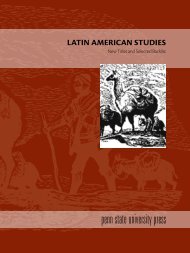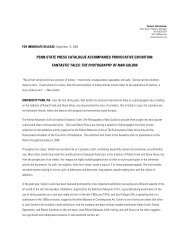Download the Catalog - Pennsylvania State University Press
Download the Catalog - Pennsylvania State University Press
Download the Catalog - Pennsylvania State University Press
Create successful ePaper yourself
Turn your PDF publications into a flip-book with our unique Google optimized e-Paper software.
A Few Scraps, Oily and O<strong>the</strong>rwise<br />
Alfred W. Smiley<br />
First published in 1907,<br />
A Few Scraps records <strong>the</strong><br />
birth of <strong>the</strong> oil industry<br />
a Few SCraPS,<br />
in <strong>Pennsylvania</strong> from<br />
oILy and o<strong>the</strong>rwISe<br />
<strong>the</strong> eyewitness perspective<br />
of Alfred Smiley, a<br />
Alfred W. Smiley<br />
<strong>Pennsylvania</strong> native who<br />
worked on <strong>the</strong> world’s<br />
first modern oil well. The<br />
“Drake” well, often called<br />
<strong>the</strong> birthplace of <strong>the</strong> modern<br />
petroleum industry,<br />
was struck on Oil Creek<br />
near Titusville, <strong>Pennsylvania</strong>,<br />
in August 1859. Smiley worked on this well and<br />
many o<strong>the</strong>rs throughout <strong>the</strong> region, riding <strong>the</strong> overnight<br />
success and eventual decline of <strong>the</strong> oil boom in <strong>the</strong> second<br />
half of <strong>the</strong> nineteenth century. Mixing a quirky personal<br />
narrative with historical information, Smiley recounts<br />
stories of <strong>the</strong> growing oil industry and its effects on life<br />
in western <strong>Pennsylvania</strong>. He describes in lucid detail <strong>the</strong><br />
early processes and practices of <strong>the</strong> oil rigs and pipelines,<br />
<strong>the</strong> fever of speculation, and <strong>the</strong> characters responsible<br />
for <strong>the</strong> creation of “oildom.” The text incorporates unique<br />
photographs from <strong>the</strong> late nineteenth century, providing a<br />
fur<strong>the</strong>r glimpse into <strong>the</strong> development of communities on<br />
<strong>the</strong> verge of modernization and industrialization.<br />
Alfred W. Smiley (1843–1927) was a clerk, administrator,<br />
and owner of several oil fields, operating his own refinery<br />
in Shamburg, <strong>Pennsylvania</strong>. He later became a member of<br />
<strong>the</strong> first board of directors of <strong>the</strong> Foxburg, St. Petersburg,<br />
and Clarion Railroad Company. In 1886 he was elected to<br />
<strong>the</strong> legislature for Clarion County, and he served as <strong>the</strong><br />
Democratic presidential elector for <strong>the</strong> twenty-seventh<br />
district of <strong>Pennsylvania</strong>.<br />
224 pages | 5 x 8 | October<br />
isbn 978-0-271-06212-9 | paper: $24.95s<br />
http://www.psupress.org/books/titles/978-0-271-06212-9.html<br />
In <strong>the</strong> Seven Mountains<br />
Legends Collected in Central <strong>Pennsylvania</strong><br />
Henry W. Shoemaker<br />
In <strong>the</strong> Seven MountaInS<br />
Legends Collected in Central <strong>Pennsylvania</strong><br />
Henry W. Shoemaker<br />
Originally published<br />
in 1913 by <strong>the</strong> Bright<br />
Printing Company, In <strong>the</strong><br />
Seven Mountains belongs<br />
to Henry Shoemaker’s<br />
robust corpus of tales<br />
and legends based on <strong>the</strong><br />
folklore of <strong>Pennsylvania</strong>.<br />
This volume presents<br />
stories from <strong>the</strong> Seven<br />
Mountains, located in<br />
Mifflin, Centre, and<br />
Juniata Counties, through<br />
which Shoemaker traveled<br />
by carriage in 1912, stopping to speak with local residents<br />
and visit “scores of localities of historic and legendary”<br />
importance. In his distinctive literary voice, Shoemaker<br />
recounts colorful legends—tales of ghosts and hauntings,<br />
of elusive mountain lions and <strong>the</strong>ir “celebrity” hunters—as<br />
well as human interest stories, many of which feature central<br />
<strong>Pennsylvania</strong> landmarks such as Tussey Mountain and<br />
Bald Mountain. Weaving narratives of <strong>the</strong> supernatural, local<br />
history, wildlife, and Native American lore, Shoemaker<br />
preserves <strong>the</strong> region’s unique cultural heritage in a series<br />
of fantastical stories that blur <strong>the</strong> lines between truth and<br />
fiction. The text, reproduced in facsimile for <strong>the</strong> first time<br />
since its original printing, includes illustrations by S. W.<br />
Smith and W. W. Sholl.<br />
Henry W. Shoemaker (1880–1958) was <strong>the</strong> author of more<br />
than twenty volumes of popular <strong>Pennsylvania</strong> literary<br />
folklore and numerous narratives about <strong>Pennsylvania</strong>’s<br />
disappearing wildlife during <strong>the</strong> first half of <strong>the</strong> twentieth<br />
century. He also served as <strong>Pennsylvania</strong>’s first state folklorist<br />
from 1948 to 1956.<br />
462 pages | 5 x 8 | October<br />
isbn 978-0-271-06213-6 | paper: $29.95s<br />
http://www.psupress.org/books/titles/978-0-271-06213-6.html<br />
Metalmark Books is a joint imprint of The <strong>Pennsylvania</strong> <strong>State</strong> <strong>University</strong> <strong>Press</strong> and<br />
<strong>the</strong> Office of Digital Scholarly Publishing at The <strong>Pennsylvania</strong> <strong>State</strong> <strong>University</strong><br />
Libraries. The facsimile editions published under this imprint are reproductions of<br />
out-of-print, public domain works that hold a significant place in <strong>Pennsylvania</strong>’s<br />
rich literary and cultural past. Metalmark editions are primarily reproduced from<br />
<strong>the</strong> <strong>University</strong> Libraries’ extensive <strong>Pennsylvania</strong> collections and in cooperation<br />
with o<strong>the</strong>r state libraries. These volumes are available to <strong>the</strong> public for viewing<br />
online and can be ordered as print-on-demand paperbacks.<br />
A complete listing of titles is available at www.psupress.org/metalmark.html.<br />
The Allegheny Pilot<br />
Containing a Complete Chart of <strong>the</strong> Allegheny River,<br />
from Warren to Pittsburgh<br />
Edwin L. Babbitt<br />
The Allegheny Pilot, first<br />
published in 1855, is<br />
an early travel guide to<br />
<strong>the</strong> aLLegheny PILot western <strong>Pennsylvania</strong>’s<br />
Containing a Complete Chart<br />
of <strong>the</strong> allegheny river,<br />
rivers and navigable<br />
from warren to Pittsburgh<br />
waterways, complete with<br />
Edwin L. Babbitt<br />
detailed maps, notes, and<br />
charts. Originally written<br />
for lumber raftsmen, and<br />
even considered to be<br />
<strong>the</strong> “Lumberman’s Bible,”<br />
it remains an important<br />
document on <strong>the</strong> original<br />
path of <strong>the</strong> Allegheny<br />
and its tributaries, which have since been changed by <strong>the</strong><br />
construction of <strong>the</strong> Kinzua Dam and o<strong>the</strong>r man-made<br />
alterations to <strong>the</strong> landscape. The book benefits not only<br />
from Babbitt’s own knowledge, experience, and research<br />
on <strong>the</strong> Allegheny, but also from his having “spent much<br />
time in conversing with many of <strong>the</strong> oldest settlers along<br />
<strong>the</strong> river, collecting from <strong>the</strong>m, orally, many historical facts<br />
besides those pertaining to <strong>the</strong> navigation of <strong>the</strong> river.” The<br />
Allegheny Pilot is a fascinating look at a transient historical<br />
landscape, in a time when <strong>the</strong> beginnings of modern<br />
industrialization began to push westward across <strong>the</strong> state’s<br />
frontiers, irrevocably changing <strong>the</strong>m.<br />
Edwin L. Babbitt (1817–1891) was a lumberman and<br />
businessman who worked in <strong>the</strong> lumber, oil, and shipping<br />
industries and lived in Warren and Grand Valley, <strong>Pennsylvania</strong>.<br />
He is buried in Youngsville, <strong>Pennsylvania</strong>.<br />
118 pages | 5.5 x 8.5 | October<br />
isbn 978-0-271-06211-2 | paper: $19.95s<br />
http://www.psupress.org/books/titles/978-0-271-06211-2.html<br />
The Life of Rev. Michael Schlatter<br />
With a Full Account of His Travels and Labors Among<br />
<strong>the</strong> Germans in <strong>Pennsylvania</strong>, New Jersey, Maryland<br />
and Virginia<br />
Henry Harbaugh<br />
First published in 1857 by<br />
<strong>the</strong> notable <strong>Pennsylvania</strong><br />
German writer Henry<br />
<strong>the</strong> LIFe oF<br />
rev. MIChaeL SChLatter<br />
Harbaugh, this volume<br />
with a Full account of his travels and<br />
Labors Among <strong>the</strong> germans in <strong>Pennsylvania</strong>, presents <strong>the</strong> biography<br />
new Jersey, Maryland and virginia<br />
of Michael Schlatter, <strong>the</strong><br />
Henry Harbaugh<br />
organizer of <strong>the</strong> German<br />
Reformed Church in<br />
<strong>Pennsylvania</strong>. Schlatter<br />
arrived in Philadelphia<br />
in 1746 on an appointment<br />
from <strong>the</strong> German<br />
Reformed Church to set<br />
up churches among <strong>the</strong><br />
growing German population in <strong>Pennsylvania</strong> and <strong>the</strong> mid-<br />
Atlantic. In addition to detailed biographical information,<br />
this book includes an English translation of his 1751 journal<br />
and a report on his time in America entitled “True History<br />
of <strong>the</strong> Real Conditions of <strong>the</strong> Destitute Congregations in<br />
<strong>Pennsylvania</strong>,” which remains an important source in <strong>the</strong><br />
study of <strong>the</strong> early German church in America and early German<br />
settlements in Philadelphia. Documenting Schlatter’s<br />
extensive travels and his work in establishing churches<br />
across <strong>Pennsylvania</strong>, Harbaugh provides an intriguing<br />
account of <strong>the</strong> formation of <strong>the</strong> early German church and<br />
<strong>the</strong> American nation during critical moments of war and<br />
political turmoil.<br />
Henry Harbaugh (1817–1867) was a writer, carpenter, and<br />
pastor of <strong>the</strong> German Reformed Church in <strong>Pennsylvania</strong>.<br />
He was a professor at Mercersburg Theological Seminary,<br />
as well as <strong>the</strong> founder of <strong>the</strong> periodicals Mercersburg Review<br />
and Reformed Messenger and <strong>the</strong> author of many books on<br />
<strong>the</strong> history of <strong>the</strong> German Reformed Church.<br />
416 pages | 5.5 x 8.5 | October<br />
isbn 978-0-271-06214-3 | paper: $32.95s<br />
http://www.psupress.org/books/titles/978-0-271-06214-3.html<br />
metalmark books<br />
30 | penn state university press www.psupress.org 1-800-326-9180 | 31
















